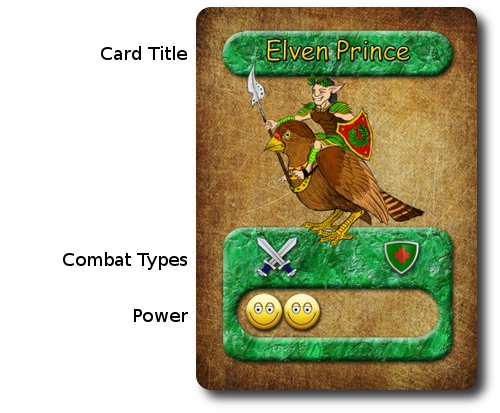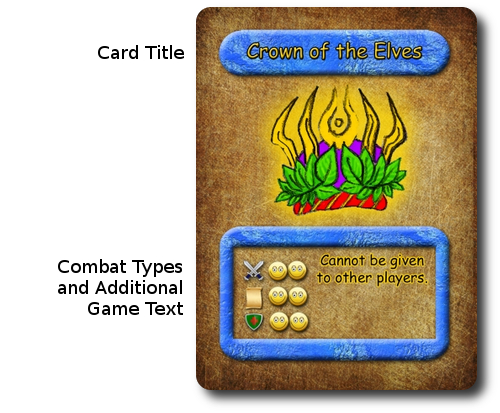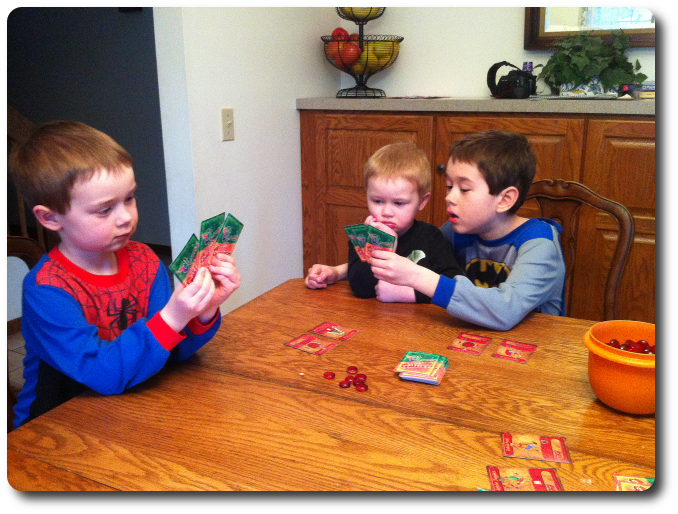
The Basics:
- For ages 5 and up (publisher suggests 12+)
- For 2 to 4 players
- Approximately 15 minutes to complete
Geek Skills:
- Active Listening & Communication
- Counting & Math
- Logical & Critical Decision Making
- Reading
- Pattern/Color Matching
- Cooperative & Team Play
- Hand/Resource Management
Learning Curve:
- Child – Easy
- Adult – Easy
Theme & Narrative:
- Work together to get back the Elven King’s treasure!
Endorsements:
- Gamer Geek rejected!
- Parent Geek approved!
- Child Geek approved!
Overview
As the Elven Kingdom slept, shadows moved in the dark. Goblins had found a way into the kingdom’s walls and were quietly making their way through the empty streets to the treasury. The elite goblins made quick work of the surprised guards and made off with the Elven King’s treasure! The next morning, the alarm was raised and you were summoned before the King. He charges you to get back that which was stolen. Success will only be possible if each hero works together!
Elves vs. Goblins, a self-published card game designed by Andreas Propst, is comprised of 60 playing cards. Not included with the game, but necessary to play, are about 60 beads or chips that can be used to keep track of “Gold Coins”. The artwork is colorful and comedic. The cards are made of thick card stock and durable, with easy to identify icons and limited card text.
Foes, Friends, and Treasures Galore
Elves vs. Goblins has three different types of cards. Each card has a specific role in the game. Each card type is summarized here.
Evildoer Cards
The Evildoer card represents the various goblins, trolls, and dragons that make up the less than well-disciplined Goblin Army. What they lack in wit and skill they more than make up for in sheer numbers, however. Each Evildoer has two or more attributes that further define its overall threat level to the players. The first three attributes represent the Evildoer’s combat types (of which the Evildoer card might have 1 to 3 of). These are Attack (represented by a crossed swords icon), Magic (represented by a magical scroll icon), and Defense (represented by a shield icon). The last attribute that each Evildoer will have is power. An Evildoer’s power is equal to the number of “Frownies” the card has. The more “Frownies” on the Evildoer card, the more powerful it is.

Friend Cards
The Friend card represents the various elves, dragons, and other magical creatures that have come to fight beside and aid the players. Like the Evildoer cards, each Friend card uses icons to represent its attributes. The first three attributes represent the Friend’s combat types (of which the Friend card might have 1 to 3 of). These are Attack (represented by a crossed swords icon), Magic (represented by a magical scroll icon), and Defense (represented by a shield icon). The last attribute that each Friend will have is power. A Friend’s power is equal to the number of “Smilies” the card has. The more “Smilies” on the Friend card, the more powerful it is.

Treasure Cards
Treasure cards represent magical artifacts that were stolen by the Goblin Army, but are now in the possession of the players. These are powerful relics of enchantment that can boost attacks, spells, and defenses, but are only useful when used in combination with Friend cards. Accompanying each of the Treasure cards are the same icons that are listed on Evildoer and Friend cards. Like Friend cards, the “Smilies” represent the strength of the treasure. The more “Smilies” displayed, the stronger the treasure. Some Treasure cards also have additional game text that further expands and alters the standard game rules.

Game Set Up
To set up the game, shuffle the 60 playing cards and deal out to each player 5 cards. The remaining cards in the deck are placed, face-down, in the middle of the playing area. This deck is referred to as the “Draw deck”.
Second, players should now look at their hand and play out in front of them any Evildoer cards the might have. These represent the starting Goblin Army pests the players will need to deal with. If a player is dealt a hand that contains Evildoer cards that have a combined total of 10 or more total “Frownies”, they can ask for a new hand.
That’s it for game set up. Time to win back the treasure!
Cooperative Butt Kicking
The game is played in turns. On a player’s turn they will complete the following steps.
Step 1: Draw Cards
The first step taken by a player during their turn is to draw cards from the Draw deck. The number of cards drawn is dependent on the number of players in the game.
- Draw 3 cards for a 2-player game
- Draw 2 cards for a 3 to 4-player game
If an Evildoer or Friend card is drawn, they are immediately placed in front of the player, face-up, for all the other players to see. If a Treasure card is drawn, the player can either play it in front of them, face-up, or hand it to a player of their choice.
Step 2: Play Cards
The second step taken by a player during their turn allows them to play any number of Friend and Treasure cards from their hand and available on the table in front of them. All Evildoer cards in play, including those visible in front of other players, can be engaged. During this step, the active player and other players may play Friend cards (players can never play Treasure cards out of turn), but only if they are currently not surrounded by the Goblin Army. A player is considered surrounded if they have 10 or more (12 or more in a 2-player game) “Frownies” in front of them. If such is the case, they are stuck until the other players come to rescue them.
Defeating Evildoers is done by matching Friend cards with an Evildoer card that share the same number of icons (Attack, Magic, and Defence). For example, an Evildoer that shows an Attack and Magic must be matched with a Friend card that only shows an Attack and Magic icon, too. When matched, the Friend card is placed next to the Evildoer card to identify it is “engaged”. A Friend card can only be engaged to one Evildoer card during the game, and once engaged, cannot be removed. There is no limit to the number of Friend cards that can be engaged to a single Evildoer card.
Treasure cards are “boosters” to the Friend cards and cannot directly engage an Evildoer on their own. Each Treasure card that is in front of the player can only assist if a Friend card is using an attack type (Attack, Magic, or Defence) that the Treasure card provides. For example, the Sword of Power Treasure card provides an additional +2 “Smilies” when matched with a Friend card that is using the Attack icon.
If the Friends and Treasure cards ever have a combined total of “Smilies” that is equal to or higher than the “Frownies” of the engaged Evildoer card, the Evildoer is vanquished! The Evildoer and any engaged Friend cards are placed in the discard pile, but the Treasure cards remain in play.
Step 3: Award Gold Coins
The third step awards Gold Coins, which are the equivalent to victory points in the game.
- If the active player has vanquished all the Evildoer cards in front of them, they take 1 Gold Coin bead or chip (whatever is being used) and give it to a player of their choice.
- Every player that helped vanquish an Evildoer card that was discarded (by providing Friend cards) collects 1 Gold Coin.
- The active player receives 1 Gold Coin to keep if they vanquished any Evildoer cards this round (2 Gold coins if they vanquished all the Evildoers without any other player assistance).
The player’s turn is now done and the next player in turn order sequence now goes starting with step 1 noted above.
Collective Victory or Defeat
When a player cannot draw cards during step 1 because there are no more cards left in the Draw deck, the game is over. All the players now count their total number of collected Gold Coins. Elves vs. Goblins is not a game that is won by a single individual. Victory is shared, but only if all the players have collected all the stolen treasure!
- In a 2-player game, each player needs to have collected at least 20 Gold Coins
- In a 3-player game, each player needs to have collected at least 15 Gold Coins
- In a 4-player game, each player needs to have collected at least 10 Gold Coins
If all the players have collected the required number of Gold Coins or more, they win!
To learn more about Elves vs. Goblins and download free print-and-cut Gold Coin tokens for use with the game, visit the game’s web page on the Game Crafter.
Prediction
Admittedly, this is going to be a very easy game to predict and to review. Elves vs. Goblins is a rethemed version of Together We Are Strong. The same game mechanisms and rules are used with the only changes being specific game bit and icon names. Other than that, it’s the same game, but wow, what a difference a retheme makes! Together We Are Strong is a very serious game that deals with difficult life issues that can plague any of us. In startling contrast, Elves vs. Goblins is a light and upbeat fantasy-themed game that is exceedingly family friendly.
I think both the Child Geeks and the Parent Geeks are going to enjoy Elves vs. Goblins. It’s light, cooperative, and fast. At a peer level, I have no doubt the Parent Geeks will give it a miss, but as a family game, I think it will do very well. The Gamer Geeks are not going to enjoy Elves vs. Goblins in the slightest. It is way too light to even register on the periphery of the elitist gamer’s interest.
Again, teaching the is game was very easy. We have already taught a game with similar rules to our play groups. It was already an easy game to teach and to learn, made even more so with our players’ prior experience. For new players, however, you shouldn’t expect anymore than perhaps a minute or two of game explanation. You can teach as you play with Elves vs. Goblins without reducing a player’s ability to enjoy it. And so, after slapping the game in front of my two oldest little geeks, stating “you’ve already played this game, but you don’t know it yet”, I asked them what they thought of Elves vs. Goblins so far.
“Much better game idea than the one this game is based on. Much better.” ~ Liam (age 8)
“If we are all friends, does that mean you can give me all your treasure, Daddy?” ~ Nyhus (age 5)
All it took was a quick look at the cards, and my little geeks instantly recognized it as a game that already knew how to play. I was a bit concerned that their prior experience with Together We Are Strong might negatively influence their feelings towards Elves vs. Goblins, but I don’t see anything to suggest that this is true. Let’s play the game and see if all it takes is a retheme to make a game golden or it’s too close to its predecessor to be of much fun.
Final Word
The Child Geeks had a great time with the game, laughing, hooting, and hollering as they cooperatively smashed, crashed, and crushed the Goblin Army. The game is very easy to play, but it still challenged the Child Geeks enough to keep them from being bored and unengaged. The best part was when the Child Geeks awarded each other Gold Coins. At first I thought they would play favorites, but it became apparent that they were counting each player’s total Gold Coins and giving them to those players who were short. This greatly pleased me for two reason. First, is showed that the Child Geeks understood the victory condition that must be met to win the game. Second, they demonstrated the true meaning of “cooperative play”. The Child Geeks suffered a bit at first when they “overkilled” an Evildoer with too many Friend cards (thus shorting themselves of Friends later in the game). They quickly learned to add just enough to take out the enemy after their first game was a bitter defeat. All the Child Geeks, once the Evildoers were vanquished, agreed that Elves vs. Goblins was a fun game and happily gave it their approval.
Note that reading is necessary to play this game, but as this is a cooperative game, reading card text to younger Child Geeks does not reduce their effectiveness as a game player.

My two oldest little geeks get ready for a game – Oldest brother is teaching the youngest brother how to play – Awesome
The Parent Geeks thought Elves vs. Goblins was a very good cooperative family game, but not anything of interest when playing with their peers. The Parent Geeks also found the game to be a bit boring and predictable, but that didnt’ stop them from enjoying their time with their family when the game was being played. According to one Parent Geek, “I’ll approve this game simply because I enjoy playing it with my kids, but if I didn’t have kids, I wouldn’t seek out this game.” The other Parent Geeks we played the game with felt the same. Clearly, Elves vs. Goblins is meant to be a family game, and it is with a “family” the game is best enjoyed.
The Gamer Geeks didn’t like Elves vs. Goblins. Not in the slightest. I’ll spare you the quotes (as they aren’t very objective…and in some cases, a bit unkind). Needless to say, this was not a game designed with the elitist gamer in mind.
I am amazed at what a difference the rethemed version of Together We Are Strong has made at the family gaming table. There was no overly serious or gloomy cloud hanging over Elves vs. Goblins, and the mood of the game and of the players was jovial. While my little geeks enjoyed the game (as did other Child Geeks and the Parent Geeks we played it with), Elves vs. Goblins left me wanting. And, yes, I know this is a game meant for younger players and for the family, but still, I wanted more. Game play is a bit too simple for my taste and I don’t see the game lasting on my family gaming table for a long period of time. After a few games, the level of interest from all the players began to noticeably wane. The game is easy enough to win and win every time you play. We play games to be challenged, which Elves vs. Goblins certainly does, but not after you figure out how to work as a team. Once the players at the table know how the cards are used, they can crush the Evildoers with ease. As there is no way to increase the game’s difficulty, the game provides little incentive to revisit it.
Games like Elves vs. Goblins are great for the younger Child Geeks, but after a while, if a game doesn’t push you to improve, think, and explore, it ceases to amuse. I know it did for me, and I can see my oldest little geek already moving on and having no interest in the game whatsoever. For my 5-year-old, though, he’s sticking with it. His youngest brother, at age 3, is also showing a great deal of enthusiasm for the game (even though he can’t play it yet). Elves vs. Goblins will be with my family for a number of years, but only for as long as my little geeks find it interesting. There are more challenging family cooperative games available that allow for difficulty adjustments and are much deeper.
At best, Elves vs. Goblins is an excellent introductory cooperative card game that will teach teamwork, communication, and logical thinking. At worst, it’ll be a game your family plays, enjoys, but seldom returns to once you have discovered that the Goblin Army isn’t that big of a threat. Still worth playing, I think, as it will most definitely bring smiles and shouts of “HUZZAH!” to your family gaming table.
This game was given to Father Geek as a review copy. Father Geek was not paid, bribed, wined, dined, or threatened in vain hopes of influencing this review. Such is the statuesque and legendary integrity of Father Geek.



